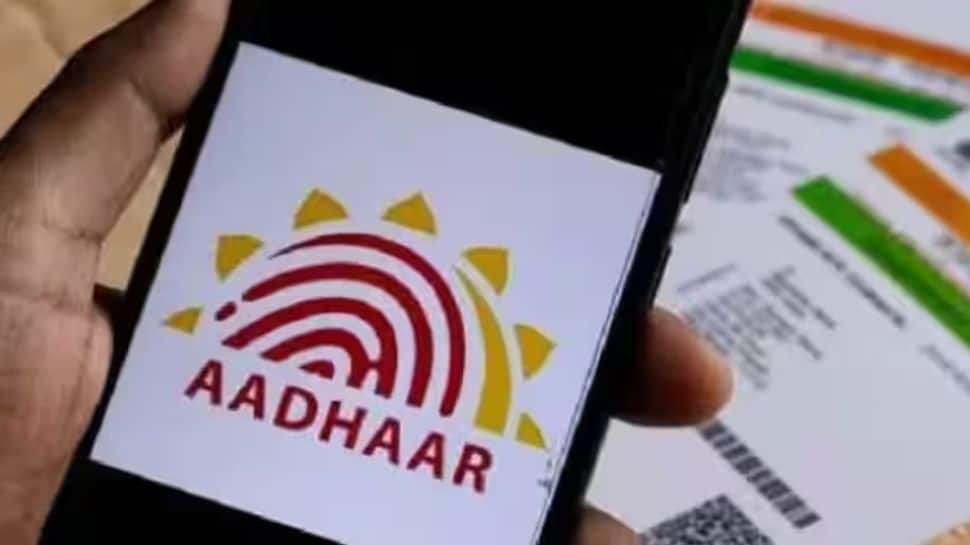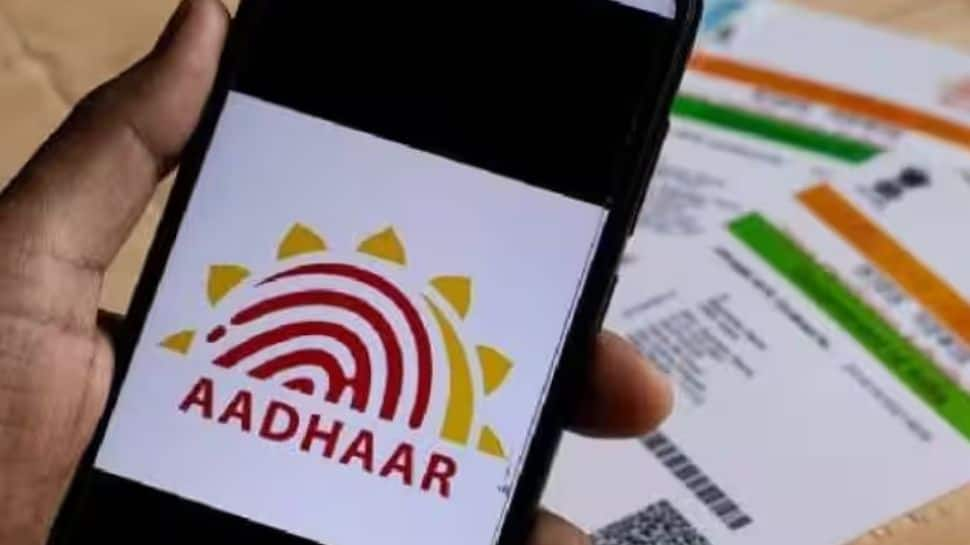Business
Aadhaar Update Charges Revised From October 2025: Check How Much You Need To Pay For Address, Identity And Biometric Update

New Delhi: Aadhaar issuing body Unique Identification Authority of India (UIDAI) has announced hike in charges related to Aadhaar services. The revised charges are effective from 1 October 2025 to 30 September 2028.
UIDAI, in an office memorandum has given all the details pertaining to revised charges for Aadhaar related services.
Charges Effective for the period from 1.10.2025 to 30.9.2028:
| S. no. | Service | Rate of assistance to registrar* ( , incl. GST) | Fee to be collected from resident by registrar/service provider ( , incl. GST) |
| 1 | Aadhaar Generation of residents in 0-5 age group (ECMP/ UC or CEL Client enrolment) | 75 | Free of cost |
| 2 | Aadhaar Generation of residents more than 5 years age | 125 | Free of cost |
| 3 | Mandatory Biometric Update (5 to 7 years and 15 to 17 years) | 125 | Free of cost |
| 4 | Aadhaar Generation of residents more than 5 years age | – | 125 |
| 5 | Other Biometric Update (with or without Demographic Update) | – | 125 |
| 6 | Demographic update (update of one or more fields) in online mode or at Aadhaar Enrolment Centre using ECMP/ UCL/ UC/ CELC | – | 75 |
| 7 | PoA/PoI Document Update at Aadhaar Enrolment Centre | – | 75 |
| 8 | PoA/PoI Document Update through SSUP (myAadhaar) Portal | – | 75 |
| 9 | Aadhaar Search using eKYC/ Find Aadhaar/any other tool & colour printout on A4 Sheet | – | 40 |
Charges Effective for the period from 1.10.2028 to 30.9.2031
| S. no. | Service | Rate of assistance to registrar ( , incl. GST) | Fee to be collected from resident by registrar/service provider ( , incl. GST) |
| 1 | Aadhaar Generation of residents in 0-5 age group (ECMP/ UC or CEL Client enrolment) | 90 | Free of cost |
| 2 | Aadhaar Generation of residents more than 5 years age | 150 | Free of cost |
| 3 | Mandatory Biometric Update (5 to 7 years and 15 to 17 years) | 150 | Free of cost |
| 4 | Mandatory Biometric Update (7 to 15 years & more than 17 years) | – | 150 |
| 5 | Other Biometric Update (with or without Demographic Update) | – | 150 |
| 6 | Demographic update (update of one or more fields) in online mode or at Aadhaar Enrolment Centre using ECMP/ UCL/ UC/ CELC | – | 90 |
| 7 | PoA/PoI Document Update at Aadhaar Enrolment Centre | – | 90 |
| 8 | PoA/PoI Document Update through SSUP (myAadhaar) Portal | – | 90 |
| 9 | Aadhaar Search using eKYC/ Find Aadhaar/any other tool & colour printout on A4 Sheet | – | 50 |
UIDAI said the charges for Home enrolment services shall be 700 (including GST) and will be charged in addition to the normal fee applicable for demographic/biometric update in Aadhaar. If the service is availed by more than one resident at the same address (as per Aadhaar), 700 service charge (including GST) will be charged for first resident and Rs 350 (including GST) for each additional resident.
Business
Markets reforms: Govt to table Securities Markets Code Bill in Winter session; unified law to merge Sebi, Depositories & trading Acts – The Times of India

The government has listed the Securities Markets Code Bill 2025 for introduction in the Winter session of Parliament starting December 1, according to a Lok Sabha bulletin. The unified legislation is aimed at boosting ease of doing business and reducing regulatory friction across India’s financial markets. The Bill proposes merging key securities laws, including the Securities and Exchange Board of India Act, 1992, the Depositories Act, 1996, and the Securities Contracts (Regulation) Act, 1956, into a single code. The unified framework was first announced in the Union Budget 2021-22, when Finance Minister Nirmala Sitharaman proposed consolidating multiple laws governing securities markets — including the Government Securities Act, 2007 — into a rationalised code. Experts said the move could reduce compliance costs and minimise overlaps between rules enacted by Sebi, depositories and the central government. Bringing the Government Securities Act within a unified code could also strengthen credibility of sovereign borrowing and help channel more foreign capital, they noted.
Business
Index reshuffle: IndiGo parent to enter Sensex from Dec 22; Tata Motors Passenger Vehicles dropped – The Times of India

InterGlobe Aviation, the operator of IndiGo, will be included in the BSE’s 30-stock benchmark index Sensex from December 22, the BSE Index Services said on Saturday.As part of the reconstitution exercise, Tata Motors Passenger Vehicles Ltd will be dropped from the index, the announcement added, PTI reported.The changes will take effect from market open on Monday, December 22, and have been made by BSE Index Services Pvt Ltd (formerly Asia Index Pvt Ltd).In the broader BSE 100 index, IDFC First Bank Ltd will be added, replacing Adani Green Energy Ltd. Within the BSE Sensex 50 index, Max Healthcare Institute Ltd will be included, while IndusInd Bank Ltd will be removed.Further, in the BSE Sensex Next 50 index, IndusInd Bank and IDFC First Bank will replace Max Healthcare Institute and Adani Green Energy.
Business
India’s New Four Labour Codes: From Gratuity After One Year To Free Annual Health Checkups; Who Will Receive Gratuity In Case Of Private Sector Employee’s Death?
)
New Labour Codes In India: The Government of India has introduced a major reform that will benefit lakhs of employees who frequently change jobs, including fixed-term employees, women, gig workers, MSME staff, and contract workers. Under the new Labour Codes, the minimum service required to receive gratuity has been reduced from five years to just one year. This means more workers will now be eligible for gratuity even if they don’t stay long in one organisation.
This major reform is part of the government’s plan to replace 29 old labour laws with four new Labour Codes. These include the Code on Wages, the Industrial Relations Code, the Social Security Code, and the Occupational Safety Code, replacing outdated regulations framed between the 1930s and 1950s. The goal is to make business processes smoother, improve worker welfare, update outdated rules, and create a more transparent and worker-friendly labour system.
Gratuity: What It Is And What Happens After Private Employee’s Death
It is a one-time amount that employers give to employees as a thank-you for their service. Under the Payment of Gratuity Act, private sector employees can receive gratuity when they leave a job (due to resignation or termination), retire, or become disabled. In case of an employee’s death, the amount is paid to their nominee. Earlier, employees had to complete at least five years of continuous service with the same employer to be eligible, except in situations of death or disability. (Also Read: What Is EPS-95 Scheme? If Employee Becomes Permanently Disabled, Will He Get Pension? Check Benefits, Eligibility Criteria, And How It Is Calculated)
New Labour Codes: How New Gratuity Rule Strengthens Worker Security?
With this reform, employees will not be penalised for having short job tenures, giving young workers who often switch jobs better financial security. It also benefits contractual, fixed-term, and gig workers by making gratuity easier to receive and more predictable. By offering gratuity to more people, the government is encouraging formal employment and improving the safety net for all workers. Overall, this change makes India’s workforce more secure and brings labour benefits closer to global standards.
New Labour Codes: Benefits Including Free Annual Health Check-Ups
For the first time, all workers, whether permanent, contractual, or fixed-term, must receive appointment letters, which improves job security and helps reduce disputes. The new Labour Codes also make preventive healthcare mandatory, requiring employers to provide yearly health checkups for workers aged 40 and above, helping with early detection and lowering long-term health risks.
Under the Code on Wages, every worker across all sectors is now entitled to minimum wages, ensuring that no one falls below a basic income level. Adding further, women are allowed to work in all types of jobs, including night shifts, giving them greater employment opportunities and flexibility.
-

 Tech1 week ago
Tech1 week agoNew carbon capture method uses water and pressure to remove CO₂ from emissions at half current costs
-

 Politics1 week ago
Politics1 week agoBritish-Pakistani honoured for transforming UK halal meat industry
-

 Business1 week ago
Business1 week agoThese 9 Common Money Mistakes Are Eating Your Income
-

 Sports7 days ago
Sports7 days agoTexas A&M officer scolds South Carolina wide receiver after touchdown; department speaks out
-

 Tech1 week ago
Tech1 week ago$25 Off Exclusive Blue Apron Coupon for November 2025
-

 Sports1 week ago
Sports1 week agoApple scrapping MLS Season Pass service in ’26
-

 Fashion1 week ago
Fashion1 week agoAfter London, Leeds and Newcastle, next stop Glasgow for busy Omnes
-

 Business1 week ago
Business1 week agoWhat’s behind Rachel Reeves’s hokey cokey on income tax rises?












